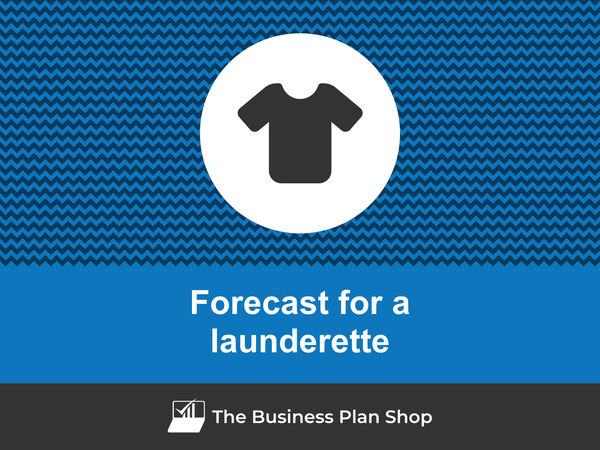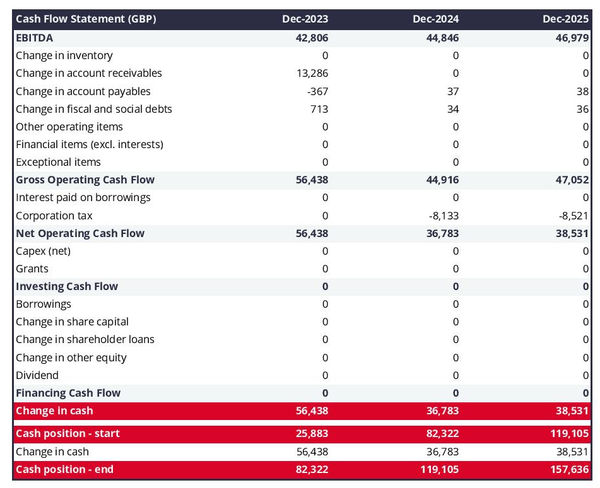How to create a financial forecast for a launderette?

Developing and maintaining an up-to-date financial forecast for your launderette is key in order to maintain visibility on your business’s future cash flows.
If you feel overwhelmed at the thought of putting together a launderette financial forecast then don’t worry as this guide is here to help you.
We'll cover everything from: the main objectives of a financial forecast, the data you need to gather before starting, to the tables that compose it, and the tools that will help you create and maintain your forecast efficiently.
Let's get started!
Why create and maintain a financial forecast for a launderette?
The financial projections for your launderette act as a financial blueprint to guide its growth with confidence and ensure its long-term financial viability.
To create them, you will need to look at your business in detail - from sales to operating costs and investments - to assess how much profit it can generate in the years to come and what will be the associated cash flows.
During challenging market conditions, maintaining an up-to-date financial forecast enables early detection of potential financial shortfalls, allowing for timely adjustments or securing financing before facing a cash crisis.
Your launderette's financial forecast will also prove invaluable when seeking financing. Banks and investors will undoubtedly request a thorough examination of your financial figures, making precision and presentation essential.
Need a solid financial forecast?
The Business Plan Shop does the maths for you. Simply enter your revenues, costs and investments. Click save and our online tool builds a three-way forecast for you instantly.

What information is used as input to build a launderette financial forecast?
A launderette's financial forecast is only as good as the inputs used to build it.
If you are creating (or updating) the forecast of an existing launderette, then you mostly need your accounting information, key historical operating non-financial data, and your team’s input on what to expect for the coming years.
If you are building financial projections for a launderette startup, you will need to have done your research and have a clear picture of your competitive environment and go-to-market strategy so that you can forecast sales accurately.
For a new venture, you will also need a precise list of the resources needed to keep the launderette running on a day-to-day basis and a list of the equipment and expenditures required to start the business (more on that later).
Let's now take a closer look at the elements that make up your launderette's financial forecast.
The sales forecast for a launderette
The sales forecast, also called topline projection, is normally where you will start when building your launderette financial forecast.
Creating a coherent sales projection boils down to estimating two key drivers:
- The average price
- The number of monthly transactions
To do this, you will need to rely on historical data (for an existing business), market research data (for both new and existing launderettes), and consider the elements below:
- The introduction of new laundry machines with advanced features can increase your average price per transaction, as customers may be willing to pay more for the convenience and quality of these machines.
- Changes in the cost of water and electricity can impact your average price per transaction, as higher utility costs may require you to increase your prices to maintain profitability.
- The local economy can affect the number of monthly transactions at your launderette. During times of economic downturn, people may choose to do their laundry at home to save money, while during times of economic growth, more people may opt for the convenience of using a launderette.
- The weather can also impact the number of monthly transactions at your launderette. During colder months, people may be less likely to do laundry at home and may choose to use a launderette instead. On the other hand, during warmer months, people may prefer to hang their laundry outside to dry, reducing the need for a launderette.
- The popularity of online shopping and home delivery services can also affect your business's average price and number of transactions. As more people choose to have their clothes delivered directly to their homes, there may be a decline in the number of people using a launderette. This may lead you to consider offering delivery services or diversifying your business to include other services.
After the sales forecast comes the operating expenses budget, which we will now look into in more detail.
Need inspiration for your business plan?
The Business Plan Shop has dozens of business plan templates that you can use to get a clear idea of what a complete business plan looks like.

The operating expenses for a launderette
The next step is to estimate the expenses needed to run your launderette on a day-to-day basis.
These will vary based on the level of sales expected, and the location and size of your business.
But your launderette's operating expenses should include the following items at a minimum:
- Staff costs: This includes wages, benefits, and any other expenses related to your employees, such as training or uniforms.
- Accountancy fees: You may need to hire an accountant to help with bookkeeping, tax preparation, and other financial tasks for your launderette.
- Insurance costs: As a business owner, it's important to have insurance to protect your assets and cover any potential liabilities.
- Rent: If you are leasing a space for your launderette, this will be a recurring expense.
- Utility bills: This includes electricity, water, and gas expenses for running your machines and keeping your space comfortable for customers.
- Cleaning supplies: You'll need to regularly purchase detergent, fabric softener, and other cleaning products to keep your machines and facility clean.
- Maintenance and repairs: As with any equipment, your machines may require maintenance or repairs from time to time, which will incur costs.
- Marketing and advertising: To attract customers to your launderette, you may need to invest in marketing and advertising efforts, such as flyers, social media ads, and local promotions.
- Software licenses: If you use any software to manage your business, such as point-of-sale systems or inventory tracking, you'll need to pay for licenses or subscriptions.
- Banking fees: This includes charges for processing credit card payments, monthly account fees, and any other banking-related expenses.
- Inventory: If you also sell laundry products, you'll need to purchase inventory to keep your shelves stocked for customers.
- Taxes: As a business owner, you will need to pay taxes on your profits, which will vary depending on your location and business structure.
- Legal fees: If you need legal advice or assistance with contracts or other legal matters, you may need to hire a lawyer, which will incur fees.
- Equipment rental: If you don't own your machines, you may need to rent them, which will be an ongoing expense.
- Training and development: To stay competitive and provide the best service to your customers, you may need to invest in training and development for yourself and your employees.
This list is, of course, not exhaustive, and you'll have to adapt it according to your precise business model and size. A small launderette might not have the same level of expenditure as a larger one, for example.
What investments are needed to start or grow a launderette?
Once you have an idea of how much sales you could achieve and what it will cost to run your launderette, it is time to look into the equipment required to launch or expand the activity.
For a launderette, capital expenditures and initial working capital items could include:
- Washing machines: These are the main source of income for a launderette, so it is important to include them in your expenditure forecast. You will need to budget for the cost of purchasing new washing machines or replacing old ones as they break down over time.
- Dryers: Like washing machines, dryers are essential for a launderette and will also need to be budgeted for. Consider the cost of purchasing new dryers or repairing existing ones as part of your expenditure forecast.
- Coin dispensers: In order for customers to use your machines, you will need to have coin dispensers available. These can be expensive and will need to be factored into your forecast. You may also need to budget for maintenance or repairs of the dispensers.
- Furniture and fixtures: A launderette will need some basic furniture and fixtures, such as tables and chairs for customers to use while waiting for their laundry. These items may need to be replaced or updated over time and should be included in your expenditure forecast.
- Security system: In order to protect your business and your customers, it is important to invest in a good security system for your launderette. This may include cameras, alarms, and other security measures. Make sure to include the cost of installation and any ongoing maintenance in your forecast.
Again, this list will need to be adjusted according to the specificities of your launderette.
Need a convincing business plan?
The Business Plan Shop makes it easy to create a financial forecast to assess the potential profitability of your projects, and write a business plan that’ll wow investors.

The financing plan of your launderette
The next step in the creation of your financial forecast for your launderette is to think about how you might finance your business.
You will have to assess how much capital will come from shareholders (equity) and how much can be secured through banks.
Bank loans will have to be modelled so that you can separate the interest expenses from the repayments of principal, and include all this data in your forecast.
Issuing share capital and obtaining a bank loan are two of the most common ways that entrepreneurs finance their businesses.
What tables compose the financial plan for a launderette?
Now let's have a look at the main output tables of your launderette's financial forecast.
The profit & loss forecast
The forecasted profit & loss statement will enable you to visualise your launderette's expected growth and profitability over the next three to five years.

A financially viable P&L statement for a launderette should normally show:
- Sales growing above inflation
- Stable or expanding (ideally) profit margins
- A net profit
This will of course depend on the stage of your business: a new venture might be loss-making until it reaches its breakeven point in year 2 or 3, for example.
The projected balance sheet
The projected balance sheet gives an overview of your launderette's financial structure at the end of the financial year.
It is composed of three categories of items: assets, liabilities and equity:
- Assets: are what the business possesses and uses to produce cash flows. It includes resources such as cash, buildings, equipment, and accounts receivable (money owed by clients).
- Liabilities: are the debts of your launderette. They include accounts payable (money owed to suppliers), taxes due and bank loans.
- Equity: is the combination of what has been invested by the business owners and the cumulative profits to date (which are called retained earnings). Equity is a proxy for the value of the owner's stake in the business.

The cash flow projection
The cash flow forecast of your launderette will show how much cash the business is expected to generate or consume over the next three to five years.

There are multiple ways of presenting a cash flow forecast but from experience, it is better to organise it by nature in order to clearly show these elements:
- Operating cash flow: how much cash is generated by the launderette's operations
- Investing cash flow: what is the business investing to expand or maintain its equipment
- Financing cash flow: is the business raising additional funds or repaying financiers (debt repayment, dividends)
Your cash flow forecast is the most important element of your overall financial projection and that’s where you should focus your attention to ensure that your launderette is adequately funded.
Note: if you are preparing a financial forecast in order to try to secure funding, you will need to include both a yearly and monthly cash flow forecast in your launderette's financial plan.
Need a solid financial forecast?
The Business Plan Shop does the maths for you. Simply enter your revenues, costs and investments. Click save and our online tool builds a three-way forecast for you instantly.

Which tool should you use to create your launderette's financial projections?
Building a launderette financial forecast is not difficult provided that you use the right tool for the job. Let’s see what options are available below.
Using online financial forecasting software to build your launderette's projections
The modern and easiest way is to use professional online financial forecasting software such as the one we offer at The Business Plan Shop.
There are several advantages to using specialised software:
- You can easily create your financial forecast by letting the software take care of the financial calculations for you without errors
- You have access to complete financial forecast templates
- You get a complete financial forecast ready to be sent to your bank or investors
- You can easily track your actual financial performance against your financial forecast, and recalibrate your forecast as the year goes by
- You can create scenarios to stress test your forecast's main assumptions
- You can easily update your forecast as time goes by to maintain visibility on future cash flows
- You have a friendly support team on standby to assist you when you are stuck
- It’s cost-efficient and much cheaper than using an accountant or consultant (see below)
If you are interested in this type of solution, you can try our forecasting software for free by signing up here.
Calling in a financial consultant or chartered accountant
Outsourcing the creation of your launderette financial forecast is another possible solution.
This will cost more than using software as you can expect as your price will have to cover the accountant’s time, software cost, and profit margin.
Price can vary greatly based on the complexity of your business. For a small business, from experience, a simple three-year financial forecast (including a balance sheet, income statement, and cash flow statement) will start at around £700 or $1,000.
Bear in mind that this is for forecasts produced at a single point in time, updating or tracking your forecast against actuals will cost extra.
If you decide to outsource your forecasting:
- Make sure the professional has direct experience in your industry and is able to challenge your assumptions constructively.
- Steer away from consultants using sectorial ratios to build their client’s financial forecasts (these projections are worthless for a small business).
Why not use a spreadsheet such as Excel or Google Sheets to build your launderette's financial forecast?
You and your financial partners need numbers you can trust. Unless you have studied finance or accounting, creating a trustworthy and error-free launderette financial forecast on a spreadsheet is likely to prove challenging.
Financial modelling is very technical by nature and requires a solid grasp of accounting principles to be done without errors. This means that using spreadsheet software like Excel or Google Sheets to create accurate financial forecasts is out of reach for most business owners.
Creating forecasts in Excel is also inefficient nowadays:
- Software has advanced to the point where forecasting can be done much faster and more accurately than manually on a spreadsheet.
- With artificial intelligence, the software is capable of detecting mistakes and helping decision-making.
Spreadsheets are versatile tools but they are not tailor-made for reporting. Importing your launderette's accounting data in Excel to track actual vs. forecast is incredibly manual and tedious (and so is keeping forecasts up to date). It is much faster to use dedicated financial planning tools like The Business Plan Shop which are built specially for this.
Need a convincing business plan?
The Business Plan Shop makes it easy to create a financial forecast to assess the potential profitability of your projects, and write a business plan that’ll wow investors.

Use our financial projection templates for inspiration
The Business Plan Shop has dozens of financial forecast templates available.
Our examples contain a complete business plan with a financial forecast and a written presentation of the company, the team, the strategy, and the medium-term objectives.
Whether you are just starting out or already have your own launderette, looking at our financial forecast template is a good way to:
- Understand what a complete business plan should look like
- Understand how you should model financial items for your launderette

Takeaways
- A financial forecast shows expected growth, profitability, and cash generation metrics for your launderette.
- Tracking actuals vs. forecast and having an up-to-date financial forecast is key to maintaining visibility on your future cash flows.
- Using financial forecasting software is the modern way of creating and maintaining financial projections.
We hope that this guide helped you gain a clearer perspective on the steps needed to create the financial forecast for a launderette. Don't hesitate to contact us if you have any questions!
Need inspiration for your business plan?
The Business Plan Shop has dozens of business plan templates that you can use to get a clear idea of what a complete business plan looks like.

Also on The Business Plan Shop
Know someone who runs a launderette? Share our business guide with them!




